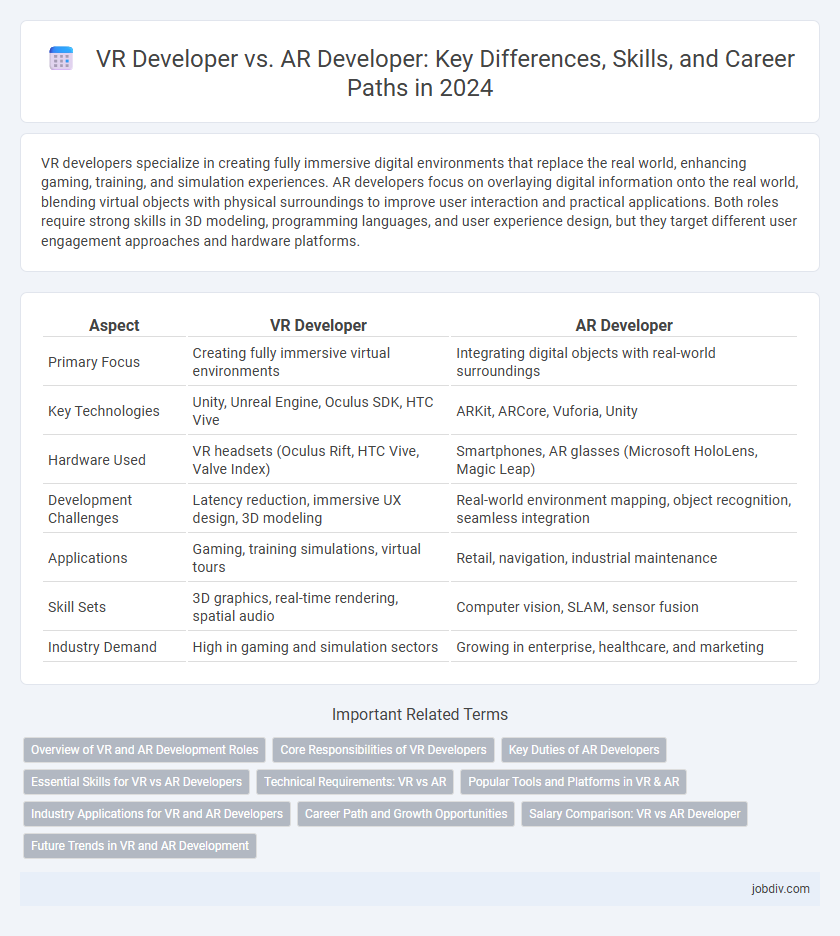VR developers specialize in creating fully immersive digital environments that replace the real world, enhancing gaming, training, and simulation experiences. AR developers focus on overlaying digital information onto the real world, blending virtual objects with physical surroundings to improve user interaction and practical applications. Both roles require strong skills in 3D modeling, programming languages, and user experience design, but they target different user engagement approaches and hardware platforms.
Table of Comparison
| Aspect | VR Developer | AR Developer |
|---|---|---|
| Primary Focus | Creating fully immersive virtual environments | Integrating digital objects with real-world surroundings |
| Key Technologies | Unity, Unreal Engine, Oculus SDK, HTC Vive | ARKit, ARCore, Vuforia, Unity |
| Hardware Used | VR headsets (Oculus Rift, HTC Vive, Valve Index) | Smartphones, AR glasses (Microsoft HoloLens, Magic Leap) |
| Development Challenges | Latency reduction, immersive UX design, 3D modeling | Real-world environment mapping, object recognition, seamless integration |
| Applications | Gaming, training simulations, virtual tours | Retail, navigation, industrial maintenance |
| Skill Sets | 3D graphics, real-time rendering, spatial audio | Computer vision, SLAM, sensor fusion |
| Industry Demand | High in gaming and simulation sectors | Growing in enterprise, healthcare, and marketing |
Overview of VR and AR Development Roles
VR developers specialize in creating immersive virtual environments using 3D modeling, game engines like Unity or Unreal, and programming languages such as C# or C++. AR developers focus on integrating digital elements into the real world through technologies like ARKit, ARCore, and computer vision algorithms. Both roles require expertise in spatial computing, user interaction design, and performance optimization to deliver seamless augmented or virtual experiences.
Core Responsibilities of VR Developers
VR developers specialize in creating immersive virtual environments by designing 3D models, coding interactive elements, and optimizing performance for VR hardware. They focus on software development using platforms like Unity and Unreal Engine to ensure seamless user experiences within fully simulated digital worlds. Debugging VR applications and integrating sensory feedback systems such as haptics are critical responsibilities to enhance realism and user engagement.
Key Duties of AR Developers
AR developers specialize in designing and implementing augmented reality experiences by integrating digital content with the physical environment using tools like ARKit, ARCore, and Unity. Their key duties include creating 3D models, coding interactive features, and optimizing applications for diverse hardware such as smartphones, tablets, and AR glasses. They also collaborate closely with UX designers and hardware engineers to ensure seamless real-world user interactions and accurate motion tracking.
Essential Skills for VR vs AR Developers
VR developers require strong expertise in 3D modeling, real-time rendering, and immersive environment design using platforms like Unity or Unreal Engine. AR developers must excel in computer vision, markerless tracking, and integration of digital content with the physical world through SDKs such as ARKit and ARCore. Both roles demand proficiency in programming languages like C# or C++, but AR development prioritizes spatial awareness and sensor integration more heavily than VR.
Technical Requirements: VR vs AR
VR developers require proficiency in 3D modeling, game engines like Unity or Unreal, and immersive environment design to create fully virtual experiences. AR developers must have expertise in spatial mapping, real-world object recognition, and SDKs such as ARKit, ARCore, or Vuforia for overlaying digital content onto the physical world. Both roles demand strong skills in programming languages like C# or C++, but AR development additionally emphasizes sensor integration and real-time data processing for seamless augmentation.
Popular Tools and Platforms in VR & AR
VR developers frequently utilize Unity and Unreal Engine for creating immersive virtual environments, leveraging tools such as Oculus SDK and SteamVR to optimize hardware compatibility. AR developers rely on platforms like ARKit and ARCore, using development kits from companies like Vuforia and Wikitude to enhance augmented reality experiences on mobile devices. Both VR and AR developers often incorporate 3D modeling software such as Blender or Maya to design interactive assets tailored to their respective spatial interfaces.
Industry Applications for VR and AR Developers
VR developers primarily focus on immersive experiences for gaming, training simulations, and virtual tourism, enabling users to engage fully in digital worlds. AR developers enhance real-world environments with interactive overlays, widely applied in retail, healthcare for surgery assistance, and manufacturing for maintenance guidance. Both roles drive innovation in education, real estate, and marketing by leveraging their respective technologies to create dynamic user interactions.
Career Path and Growth Opportunities
VR developers specialize in creating immersive virtual environments using software like Unity and Unreal Engine, focusing on gaming, training simulations, and healthcare applications. AR developers work with platforms such as ARKit and ARCore to overlay digital content onto the real world, enhancing experiences in retail, education, and industrial maintenance. Career growth in VR often leads to roles in creative direction and simulation design, while AR developers can advance into spatial computing and mixed reality solution architecture.
Salary Comparison: VR vs AR Developer
VR developers typically earn higher average salaries due to specialized skills in immersive 3D environment creation and advanced hardware integration. AR developers command competitive pay by leveraging expertise in real-world overlay technologies and mobile platform optimization. Industry demand, technical complexity, and project scope significantly influence salary disparities between VR and AR development roles.
Future Trends in VR and AR Development
VR developers are increasingly integrating AI-driven environments to create more immersive and adaptive virtual experiences, enhancing user interaction in gaming, education, and healthcare. AR developers focus on seamless real-world integration through improved spatial mapping and 5G connectivity, enabling real-time data overlay for industries like retail, manufacturing, and navigation. Both fields are rapidly adopting edge computing and machine learning advancements to optimize latency and content personalization, signaling a future where VR and AR technologies become more accessible and context-aware.
VR Developer vs AR Developer Infographic

 jobdiv.com
jobdiv.com